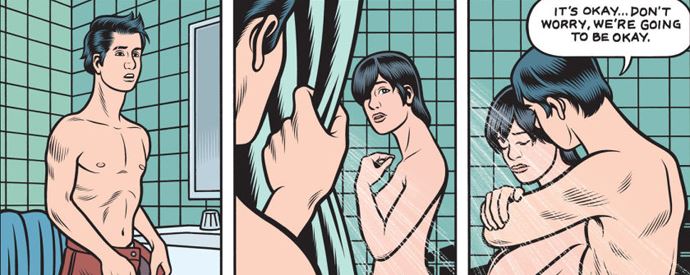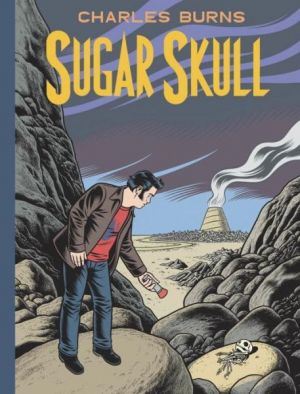Comics /
Comic Reviews /
More Comics
Charles Burns' Sugar Skull comics review

By Leroy Douresseaux
September 16, 2014 - 12:25
 |
| Sugar Skull cover image is courtesy of barnesandnoble.com. |
Follow me on
Twitter.
The graphic novel trilogy that began in
X'ed Out and continued in
The Hive comes to an end with
Sugar Skull, written and drawn by the trilogy's creator,
Charles Burns. The long strange trip of a guy named Doug comes to an end that is both mind-bending and heart-wrenching (or pathetic, depending on how you look at it).
In X’ed Out, Burns introduced
Doug, a photographic artist who has a head injury of some kind. One night, he awakens and sees his cat,
Inky, who is supposed to be dead. Doug follows Inky through a hole torn in a brick wall, where he discovers a place called
The Hive. This place is likely an alternate reality that has been induced by the trauma Doug experienced and by the prescription medications he uses. In the Hive, Doug's persona becomes that of “
Johnny,” a version of
Nitnit, his performance art alter-ego.
In The Hive, Doug begins working in that nightmarish alternate world as a lowly employee who carts supplies around the Hive. He also strikes up a friendship with a breeder named
Suzy, and that new relationship is almost like another Doug previously had. Meanwhile, back in reality, Doug slowly transforms from an ambitious young artist into a guy who merely drifts through life, bereft of his hopes and dreams.
As
Sugar Skull begins, Doug-as-Johnny is back in the the Hive. After a troubling encounter with a sow-life creature and her thing-lets, he reunites with a his Hive-chick, Suzy. However, she is about to undergo a bodily function that disturbs and freaks-out Johnny. Meanwhile, back in reality, Doug is now fully a lost and ambivalent man, but he lives with
Sally, a woman who clearly loves him
Doug has regrets and questions. What does the Hive represent? What happened to him? Where is his former girlfriend,
Sarah? As he digs for answers, he seeks out Sarah, who has a surprise for him. We also finally learn how Doug received the head injury that has put his reality into a crazy, mind-bending, dream/nightmare loop.
THE LOWDOWN: I have enjoyed Charles Burns' trilogy of graphic novels. [I don't know whether to call this “The Hive trilogy” or the “X'ed Out trilogy” or even the “Nitnit trilogy.”] I like the publishing format for these comic books: hardcover, large-sized at 8.9 x 11.8 (which is similar to a French album or graphic novel), with a cloth-covered spine and beautifully illustrated end papers.
I found X'ed Out to be especially intriguing and captivating; I could not help but be taken in by the mystery and reality-warping, which seemed straight out of a David Lynch movie. The Hive was vague and sometimes seemed like filler material, which can be a problem with the middle installment of a trilogy. I was somewhat frustrated with it.
Four years after I read X'ed Out,
Sugar Skull rewards my patience. Suddenly, the answers pour forth, and they will break your heart. For all the surrealism of much of story prior to the final volume, this ending is surprisingly human. Burns depicts the melancholy nature of a promising life that has decided to settle for the mundane.
This trilogy operates on so many levels and layers, and Doug and perhaps a few other characters exist in different persona. Time, symbolism, and metaphor exist in multiple layers.
Sugar Skull is more grounded than the other books. It forces reality and consequence, even in the alternate reality. A “sugar skull” or calavera is a representation of the human skull made out of clay or sugar and is used in the Mexican celebration, Day of the Dead (which takes place over three days beginning on October 31st).
Is Doug dead? Is he an unreliable narrator? I don't think that Doug is a deceased character, who is narrating the last of his life. Rather, he is forced to confront the truth about himself, and that can be more painful than a blow to the head.
Sugar Skull justifies this entire enterprise undertaken by Charles Burns, and it proves that Burns' stories may be strange and intense, but they are not impersonal. They are unique depictions of the human condition, and, as
Sugar Skull shows, they are deeply personal.
POSSIBLE AUDIENCE: Readers looking for great comic books will find that in the graphic novel,
Sugar Skull.
www.facebook.com/pantheonbooks
www.pantheoncomics.com
Rating: A /10
Last Updated: January 17, 2025 - 08:20
